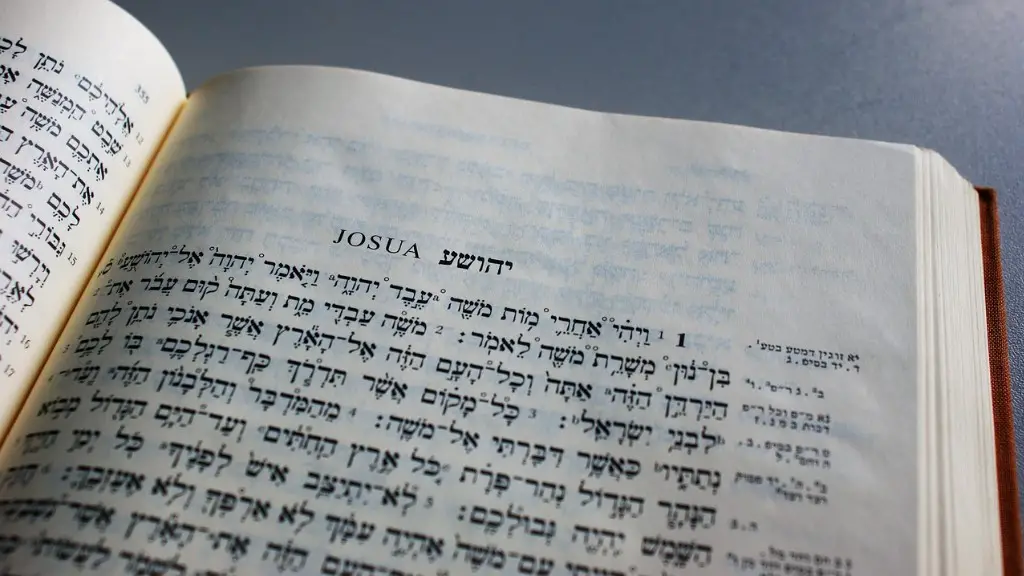Judaism is a centuries-old faith, originating in the Middle East. The language of Judaism has been used to convey its teachings and practices, stemming from the Torah and scriptures, across many generations. This language, known as Sacred Language, is entrenched in the doctrines of the faith and is unique to Judaism.
The Sacred Language of Judaism is known as Hebrew, or Lashon HaKodesh in Hebrew. It is believed to be the language of the Jewish prophets, and is the language in which the Bible was written. Hebrew is not just an ancient language; it is a living language and is taught in many Jewish institutions around the world to this day.
Modern Hebrew has evolved over time, in response to changes in the world – for instance, there is a higher chance of evoking a more contemporary understanding of certain words in contemporary Hebrew than in traditional Hebrew, such as the written language found in Torah scrolls.
In addition to Hebrew, Yiddish is commonly spoken by Jews, especially in Europe and Israel. Yiddish is a combination of several languages, including German, French and Hebrew, which resulted in a new language that was widely spoken in the Jewish communities of Central and Eastern Europe. Yiddish is now used as a language of instruction at yeshivas and in everyday conversations between Jews. While it is not the language of the Torah, it is an important part of the language landscape of many Jews.
The Sacred Language of Judaism is integral to the practice of the faith. Prayer, study, and many other Jewish rituals rely on an understanding of the Sacred Language. As such, it is held in high regard and is used to express spiritual truths that are important to the Jewish people.
For those interested in learning Hebrew and Yiddish, there are many resources available. One can take classes at a nearby Hebrew school, enroll in an online course, or buy books and audio recordings. Many synagogues and Jewish institutions also offer courses and classes related to the Sacred Language.
The Sacred Language of Judaism is a cornerstone of Jewish life. It is used to connect to the faith’s past, to express its values, and to reach understanding of its teachings. Understanding the language can bring one closer to the faith and to its ideas, and is a great way to truly experience the richness of Judaism.
Translation
Many Jewish texts that have been written in ancient or classical Hebrew have been translated into other languages, so as to make them more accessible to a wider audience. This enables those without a full command of the Sacred Language to gain valuable insight from ancient Jewish texts.
Aside from ancient texts, there are also many translations of modern day Jewish teachings. This allows for those with varying levels of understanding of the Sacred Language to benefit from the faith.
In more recent times, the use of machine translation has made it possible to turn text written in Hebrew into other languages in just a few clicks. This has made it much easier to access Jewish texts and teachings, and has opened up new opportunities for those wanting to access Israel’s antiquity.
The Hebrew Alphabet
The Hebrew alphabet consists of 22 letters, some of which are written differently depending on their position in a word. Each of these letters also has a numerical value. This is known as gematria, and is used to interpret the meaning of a word, or to spell out the numerical distinctions of a text.
The Hebrew alphabet is also used in numerology and kabbalah, ancient forms of Jewish mysticism. The letters and words of the Hebrew alphabet can be used to determine the hidden meanings in texts, as well as to learn about the spiritual energies contained in each letter.
Hebrew In The Home
The use of Hebrew in the home is an important part of Jewish life. Many Jewish families raise their children to be able to fluently speak and understand the Sacred Language. This is done in order to help the children to appreciate their religious and cultural heritage more deeply, and to give them access to important texts such as the Bible. Many Jewish families also make it a priority to practice the mitzvot, or commandments, of Judaism in the language of Hebrew.
Learning to speak and understand Hebrew in the home is a great way to pass on the values of the faith to the next generation. It can create stronger connections between parents and their children, and can also help to create a more unified and understanding community.
The Significance Of Hebrew
Hebrew is a language of great significance in the Jewish faith. Not only is it the language of the Torah, and of most of the Hebrew Bible, but it is also the language of Jewish prayer, study, and tradition. It is a living language, which has evolved over time and is still used by Jews around the world. Mastery of the language is highly revered in many Jewish communities, and is seen as evidence of one’s connection to their faith.
In short, the Sacred Language of Judaism is Hebrew. It is a language that is both ancient, and modern. It is a language of great spiritual significance and is used in many aspects of Jewish life, from prayer to study. Understanding it is an important way to connect with Jewish cultural and religious heritage, and to fully experience Jewish life.
Hebrew In Popular Culture
The Hebrew language has also gained prominence in popular culture in recent times, as many celebrities and public figures have embraced it and used it to communicate their artistic visions. Examples include rapper Drake, who regularly uses Hebrew words in his music, and Madonna, who sang “Like A Prayer” in both English and Hebrew.
The prominence of Hebrew in music and films has made it a symbol of Jewish heritage, and has helped to connect Judaism to popular culture. It has also helped to bring attention to important issues in the Jewish community, such as refugees and the struggle for freedom. It has served to open up the conversations and make them more accessible to the public.
The Revival Of Hebrew
The revival of Hebrew as a spoken language can be traced back to the late 19th century, when Eliezer Ben Yehuda began to advocate for its use as the spoken language of Jewish people in the Land of Israel. This was met with opposition from some quarters, as Hebrew had not been spoken as a primary language for centuries, and there were doubts about its suitability for everyday life. However, over the years, Hebrew has been embraced by many, and has become a symbol of Jewish pride and identity.
Today, Hebrew is spoken in many parts of the world and is used by Jews from all walks of life. It is used as the language of instruction in many Jewish schools, and has become a source of pride for many Jews. The revival of Hebrew has been of great significance to the Jewish people, and it has been a great source of inspiration to many.
Conclusion
The Sacred Language of Judaism is Hebrew. It is a language that has been used to express the faith’s teachings and practices for centuries, and is held in high esteem by Jews across the world. Learning the language is a great way to gain a deeper appreciation and understanding of Jewish culture, and to truly experience Jewish life.



